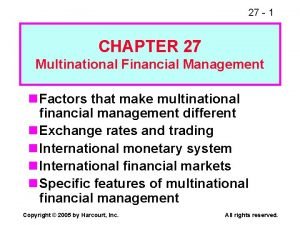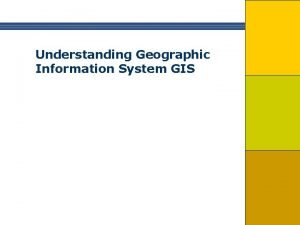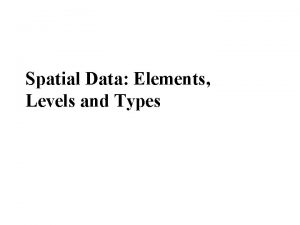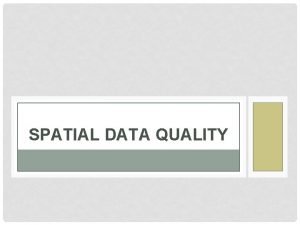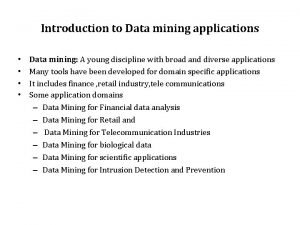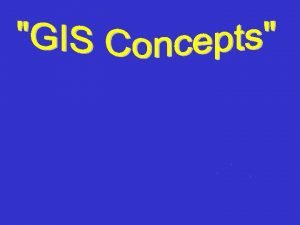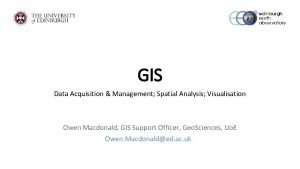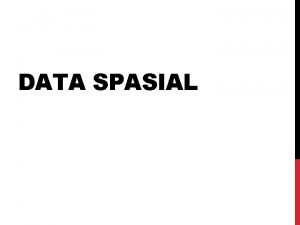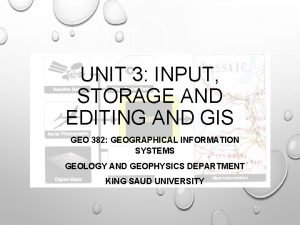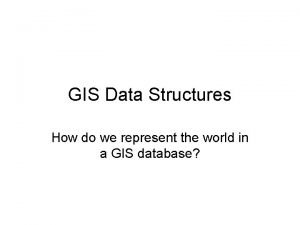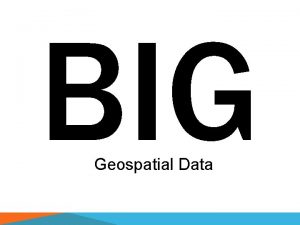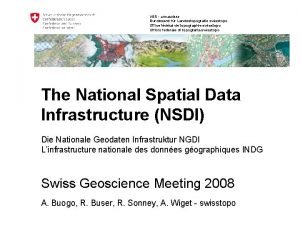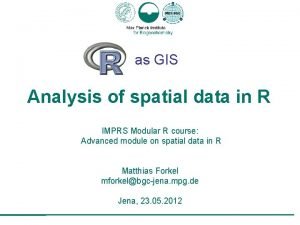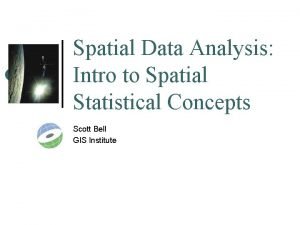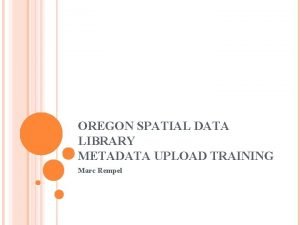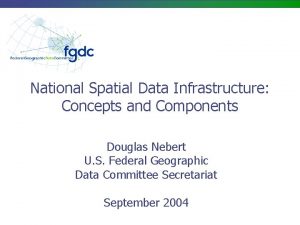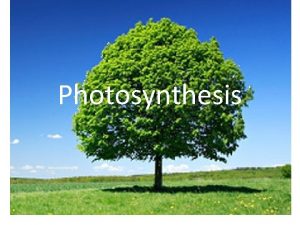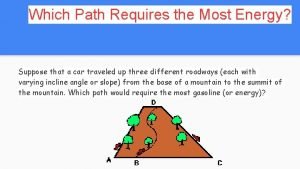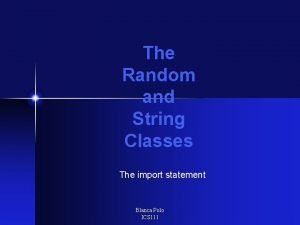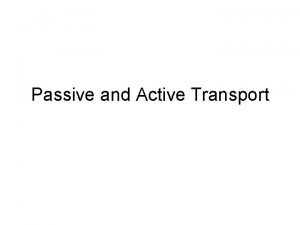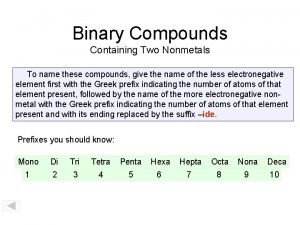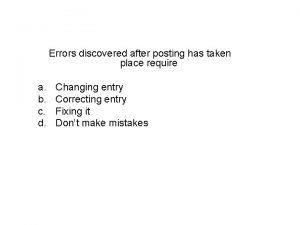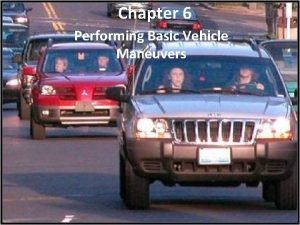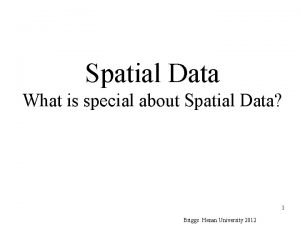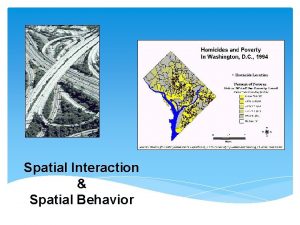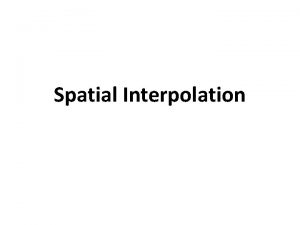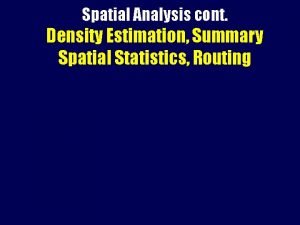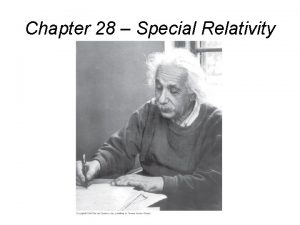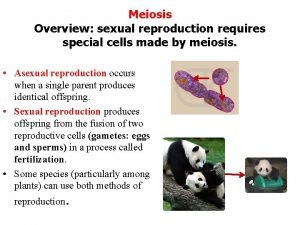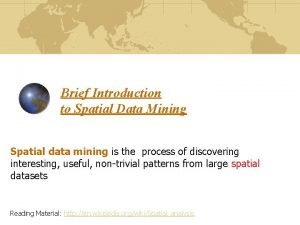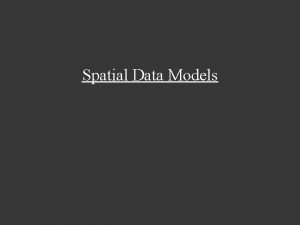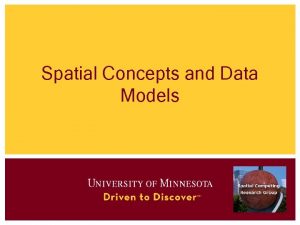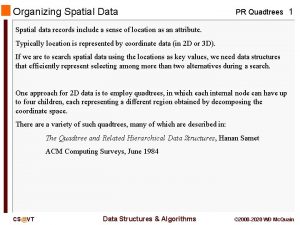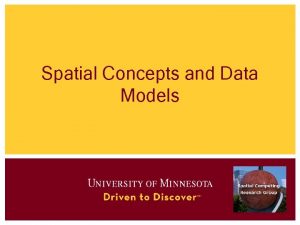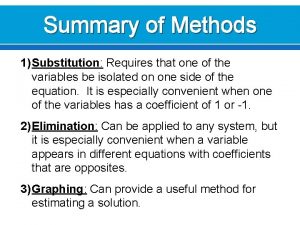Spatial Data Management Summary Spatial data requires special


















































- Slides: 50

Spatial Data Management

Summary � Spatial data requires special data structures, similar to B-trees

Lecture outline � Types of spatial data � Example of spatial and geometric data – splines and Voronoi diagrams � One-dimensional index – interval trees � R-trees � T-tree variants

Types of Spatial Data � Point Data ◦ Points in a multidimensional space ◦ E. g. , Raster data such as satellite imagery, where each pixel stores a measured value ◦ E. g. , Feature vectors extracted from text � Region Data ◦ Objects have spatial extent with location and boundary ◦ DB typically uses geometric approximations constructed using line segments, polygons, etc. , called vector data.

Examples of GIS data � Different types of sampling are used to collect data

Splines

Examples of Voronoi regions

Terrain from splines and Voronoi diagrams

Spatial filtering

Spatial filtering � Low-pass filter – the value for the cell is computed as average of other cells � High-pass-continuous surface –low pass

Spatial filtering � Window size has effect on filtering

Smoothing of maps

Types of Spatial Queries � Spatial Range Queries ◦ Find all cities within 50 miles of Madison ◦ Query has associated region (location, boundary) ◦ Answer includes ovelapping or contained data regions � Nearest-Neighbor Queries ◦ Find the 10 cities nearest to Madison ◦ Results must be ordered by proximity � Spatial Join Queries ◦ Find all cities near a lake ◦ Expensive, join condition involves regions and proximity

Applications of Spatial Data � Geographic Information Systems (GIS) ◦ E. g. , ESRI’s Arc. Info; Open. GIS Consortium ◦ Geospatial information ◦ All classes of spatial queries and data are common � Computer-Aided Design/Manufacturing ◦ Store spatial objects such as surface of airplane fuselage ◦ Range queries and spatial join queries are common � Multimedia Databases ◦ Images, video, text, etc. stored and retrieved by content ◦ First converted to feature vector form; high dimensionality ◦ Nearest-neighbor queries are the most common

Single-Dimensional Indexes � B+ trees are fundamentally single-dimensional indexes. � When we create a composite search key B+ tree, e. g. , an index on <age, sal>, we effectively linearize the 2 dimensional space since we sort entries first by age and then by sal. Consider entries: <11, 80>, <12, 10> <12, 20>, <13, 75> 80 70 60 50 40 30 20 10 B+ tree order 11 12 13

Multidimensional Indexes �A multidimensional index clusters entries so as to exploit “nearness” in multidimensional space. � Keeping track of entries and maintaining a balanced index structure presents a challenge! Consider entries: <11, 80>, <12, 10> <12, 20>, <13, 75> 80 70 60 50 40 30 20 10 Spatial clusters 11 12 13 B+ tree order

Motivation for Multidimensional Indexes � Spatial queries (GIS, CAD). ◦ Find all hotels within a radius of 5 miles from the conference venue. ◦ Find the city with population 500, 000 or more that is nearest to Kalamazoo, MI. ◦ Find all cities that lie on the Nile in Egypt. ◦ Find all parts that touch the fuselage (in a plane design). � Multidimensional range queries. ◦ 50 < age < 55 AND 80 K < sal < 90 K

Motivation � Similarity queries (content -based retrieval). ◦ Given a face, find the five most similar faces/expressions.

Interval trees � Geometric, 1 -dimensional tree � Interval is defined by (x 1, x 2) � Split at the middle (5), again at the middle (3, 7), again at the middle (2, 8) � All intervals intersecting a middle point are stored at the corresponding root. (4, 6) (4, 8) (2, 4) 1 2 3 4 5 6 7 8 9 (6, 9) (7. 5, 8. 5)

Interval trees �Finding intervals – by finding x 1, x 2 against the nodes �Find interval containing specific value – from the root �Sort intervals within each node of the tree according to their coorsinates �Cost of the “stabbing query”– finding all intervals containing the specified value is O(log n + k), where k is the number of reported intervals.

SAM (Spatial Access Method) � Constructs the minimal bounding box (mbb) � Check validity (predicate) on mbb � Refinement step verifies if actual objects satisfy the predicate.

What’s the difficulty? � An index based on spatial location needed. ◦ One-dimensional indexes don’t support multidimensional searching efficiently. ◦ Hash indexes only support point queries; want to support range queries as well. ◦ Must support inserts and deletes gracefully. � Ideally, want to support non-point data as well (e. g. , lines, shapes). � The R-tree meets these requirements, and variants are widely used today.

The R-Tree � The R-tree is a tree-structured index that remains balanced on inserts and deletes. � Each key stored in a leaf entry is intuitively a box, or collection of intervals, with one interval per dimension. � Example in 2 -D: Root of R Tree Y X Leaf level

R-Tree Properties � Leaf entry = < n-dimensional box, rid > ◦ This is Alternative (2), with key value being a box. ◦ Box is the tightest bounding box for a data object. � Non-leaf node > entry = < n-dim box, ptr to child ◦ Box covers all boxes in child node (in fact, subtree). � All leaves at same distance from root. � Nodes can be kept 50% full (except root). ◦ Can choose a parameter m that is <= 50%, and ensure that every node is at least m% full.

Example of an R-Tree Leaf entry Index entry R 1 R 4 R 3 R 8 R 9 R 10 R 11 Spatial object approximated by bounding box R 8 R 5 R 13 R 14 R 12 R 7 R 6 R 15 R 18 R 17 R 16 R 19 R 2

Example R-Tree (Contd. ) R 1 R 2 R 3 R 4 R 5 R 8 R 9 R 10 R 11 R 12 R 6 R 7 R 13 R 14 R 15 R 16 R 17 R 18 R 19

Search for Objects Overlapping Box Q Start at root. 1. If current node is non-leaf, for each entry <E, ptr>, if box E overlaps Q, search subtree identified by ptr. 2. If current node is leaf, for each entry <E, rid>, if E overlaps Q, rid identifies an object that might overlap Q. Note: May have to search several subtrees at each node! (In contrast, a B-tree equality search goes to just one leaf. )

Improving Search Using Constraints � It is convenient to store boxes in the R-tree as approximations of arbitrary regions, because boxes can be represented compactly. � But why not use convex polygons to approximate query regions more accurately? ◦ Will reduce overlap with nodes in tree, and reduce the number of nodes fetched by avoiding some branches altogether. ◦ Cost of overlap test is higher than bounding box intersection, but it is a main-memory cost, and can actually be done quite efficiently. Generally a win.

Insert Entry <B, ptr> � Start at root and go down to “best-fit” leaf L. ◦ Go to child whose box needs least enlargement to cover B; resolve ties by going to smallest area child. � If best-fit leaf L has space, insert entry and stop. Otherwise, split L into L 1 and L 2. ◦ Adjust entry for L in its parent so that the box now covers (only) L 1. ◦ Add an entry (in the parent node of L) for L 2. (This could cause the parent node to recursively split. )

Splitting a Node During Insertion � The entries in node L plus the newly inserted entry must be distributed between L 1 and L 2. � Goal is to reduce likelihood of both L 1 and L 2 being searched on subsequent queries. � Idea: Redistribute so as to minimize area of L 1 plus area of L 2. Exhaustive algorithm is too slow; quadratic and linear heuristics are popular in research. GOOD SPLIT! BAD!

R-Tree Variants � The R* tree uses the concept of forced reinserts to reduce overlap in tree nodes. When a node overflows, instead of splitting: ◦ Remove some (say, 30% of the) entries and reinsert them into the tree. ◦ Could result in all reinserted entries fitting on some existing pages, avoiding a split. R* trees also use a different heuristic, minimizing box perimeters rather than box areas during insertion. � Another variant, the R+ tree, avoids overlap by inserting an object into multiple leaves if necessary. � ◦ Searches now take a single path to a leaf, at cost of redundancy.

Gi. ST � The Generalized Search Tree (Gi. ST) abstracts the “tree” nature of a class of indexes including B+ trees and R-tree variants. ◦ Striking similarities in insert/delete/search and even concurrency control algorithms make it possible to provide “templates” for these algorithms that can be customized to obtain the many different tree index structures. ◦ B+ trees are so important (and simple enough to allow further specialization) that they are implemented specially in all DBMSs. ◦ Gi. ST provides an alternative for implementing other tree indexes.

Indexing High-Dimensional Data � Typically, high-dimensional datasets are collections of points, not regions. ◦ E. g. , Feature vectors in multimedia applications. ◦ Very sparse � Nearest neighbor queries are common. ◦ R-tree becomes worse than sequential scan for most datasets with more than a dozen dimensions. � As dimensionality increases contrast (ratio of distances between nearest and farthest points) usually decreases; “nearest neighbor” is not meaningful.

Comments on R-trees � Spatial data management has many applications, including GIS, CAD/CAM, multimedia indexing. ◦ Point and region data ◦ Overlap/containment and nearest-neighbor queries � Many approaches to indexing spatial data ◦ R-tree approach is widely used in GIS systems ◦ Other approaches include Grid Files, Quad trees, and techniques based on “space-filling” curves. ◦ For high-dimensional datasets, unless data has good “contrast”, nearest-neighbor may not be well -separated

Comments on R-Trees � Deletion consists of searching for the entry to be deleted, removing it, and if the node becomes under-full, deleting the node and then re-inserting the remaining entries. � Overall, works quite well for 2 and 3 D datasets. Several variants (notably, R+ and R* trees) have been proposed; widely used. � Can improve search performance by using a convex polygon to approximate query shape (instead of a bounding box) and testing for polygon-box intersection.

The grid � "Print Gallery, " by M. C. Escher. Curious about the blank spot in the middle of Escher’s 1956 lithograph, Hendrik Lenstra set out to learn whether the artist had encountered a mathematical problem he couldn’t solve. © 2002 Cordon Art B. V. , Baarn, Holland. All rights reserved.

The grid structure � Fixed grid: � Stored as a 2 D array, each entry contains a link to a list of points (object) stored in a grid. a, b

Page overflow � Too many points in one grid cell: Solution A –overflow (linked list) Solution B- Split the cell and increase index!

Rectangle indexing with grids � Rectangles may share different grid cells � Rectangle duplicates are stored � Grid cells are of fixed size

Grid file vs. grid �In a grid file, the index is dynamically increased in size when overflow happens. �The space is split by a vertical or a horizontal line, and then further subdivided when overflow happens! �Index is dynamically growing �Boundaries of cells of different sizes are stores, thus point and stabbing queries are easy

The quadtree � Instead tree! of using an array as an index, use � Quadtree decomposition – cells are indexed by using quaternary B-tree. � All cells are squares, not polygons. � Search in a tree is faster!

Quad-tree example First three levels of a quad tree

Image stored in a quad-tree 8 x 8 pixel picture represented in a quad tree � Project #32: PICTURE REPRESENTATION USING QUAD TREES, Mc. Gill University:

Grid file � Example of a grid file

Linear quadtree � B+ index – actual references to rectangles are stored in the leaves, saving more space+ access time � Label nodes according to Z or “pi” order

Linear quadtree � Level of detail increases as the number of quadtree decompositions increases! Decompositions have indexes of a form: 00, 01, 02, 03, 10, 11, 12, 13, 2, 300 301 , 302 , 303 , 31 , 32 , 33 ◦ Stores as Bplus tree

Z-order


Review questions � What is spatial data structure? � What is the difference between grid and grid file? � Explain how z or p ordering works? � Define interval trees � Provide example of R-tree � List R-tree variants � How spatial index structure differs from regular B+ tree?

Resources � Text 1 instructor’s resources � Mc. Gill University web space � Wikepedia (z order images) � Face recognition research � SPARCS lab project on image processing
 Oflinemaps
Oflinemaps Interest rate parity example
Interest rate parity example Multinational financial management requires that
Multinational financial management requires that Multinational financial management requires that
Multinational financial management requires that Components of gis
Components of gis Spatial data and attribute data
Spatial data and attribute data Special relativity summary
Special relativity summary Spatial data quality
Spatial data quality Spatial data mining applications
Spatial data mining applications Spatial data acquisition
Spatial data acquisition Gis hardware components
Gis hardware components Spatial data acquisition
Spatial data acquisition Big spatial data
Big spatial data Keyboard entry in gis
Keyboard entry in gis Spatial big data platform
Spatial big data platform Spatial data structures in gis
Spatial data structures in gis Spatial data transformation
Spatial data transformation Spatial big data
Spatial big data National spatial data infrastructure
National spatial data infrastructure National spatial data infrastructure
National spatial data infrastructure R for gis
R for gis What is spatial data?
What is spatial data? Oregon spatial data library
Oregon spatial data library Spatial data infrastructure components
Spatial data infrastructure components Articles of the code of ethics are broad statements
Articles of the code of ethics are broad statements Realtor code of ethics three major sections
Realtor code of ethics three major sections Example of logical paragraph
Example of logical paragraph Importance of the level of product availability
Importance of the level of product availability Monocot คือ
Monocot คือ Photosynthesis requires
Photosynthesis requires True or false: mla requires a title page.
True or false: mla requires a title page. How many first aider is needed to do the hammock carry
How many first aider is needed to do the hammock carry Recognizing genre - argumentative text answer key
Recognizing genre - argumentative text answer key Which path requires the most energy
Which path requires the most energy Using the random class requires an import statement
Using the random class requires an import statement Zmienne symboliczne matlab
Zmienne symboliczne matlab A nine box matrix requires assessing employees on ________.
A nine box matrix requires assessing employees on ________. Vegetative reproduction requires mieosis.
Vegetative reproduction requires mieosis. Requires two parents
Requires two parents An intense play activity that requires substantial energy
An intense play activity that requires substantial energy Active transport
Active transport Endocytosis vs exocytosis
Endocytosis vs exocytosis Intersubjectivity slideshare
Intersubjectivity slideshare Awareness requires totally focusing attention on the task
Awareness requires totally focusing attention on the task Naming binary compounds
Naming binary compounds The apt requires a benchmark portfolio
The apt requires a benchmark portfolio Interpersonal communication competence requires
Interpersonal communication competence requires After posting is completed there may be an error if
After posting is completed there may be an error if Learning requires both practice and rewards
Learning requires both practice and rewards Conscience formation requires a habit of
Conscience formation requires a habit of The safest turnabout maneuver is
The safest turnabout maneuver is


